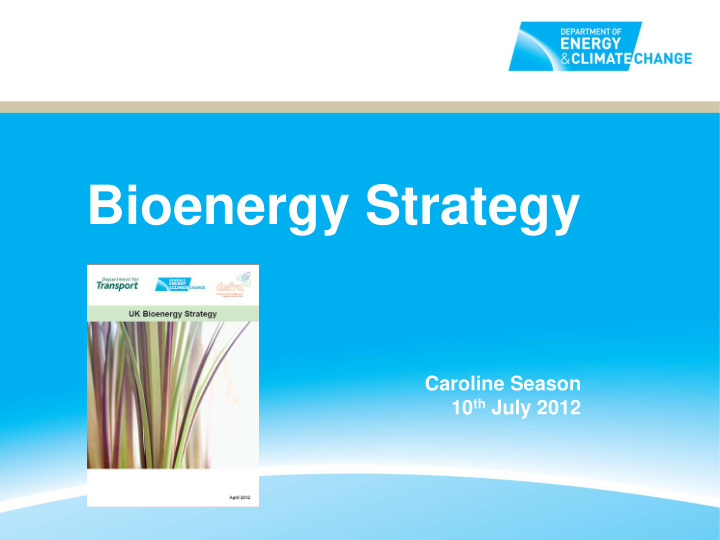



Bioenergy Strategy Caroline Season 10 th July 2012
Agenda • The UK situation • Achieving a 15% renewables target – role for biomass • Approach to developing the Bioenergy Strategy • 4 Principles for Bioenergy Policy • Feedstock supplies • Identifying the low-risk pathways • Heat and electricity deployment analysis • Priority actions
The UK situation • 61 million people and growing • 244K sq km – under ½ size of France • 250 people per sq km • 76% of farmland & 12% forest cover • 1990 – UK energy market privatised • ‘Dash for gas’ decarbonises the UK electricity supply to 430 kg CO2/MWh • >80% use gas from UK grid for heating • UK achieves large carbon reductions with a highly centralised energy supply but low renewables (under 2% of energy) • But declining North Sea output means oil/gas imports are increasing • And many of our coal power stations are due to close by 2015 – so energy security issues
EU Renewable Energy Directive (RED)
Technology breakdown (TWh) for central deployment view in 2020 Central Range for 2020 (TWh) Onshore Wind 24-32 Offshore Wind 33-58 Biomass Electricity 32-50 Marine & Tidal 1 Biomass Heat (Comm./Indust.) 36-50 Air/Ground Source Heat Pumps 16-22 Renewable Transport Up to 48 Others (inc. hydro, solar & domestic heat) 14 Estimates 15% target 234 Source: UK Renewable Energy Roadmap (July 2011)
Our approach to the Bioenergy Strategy’s development • Bioenergy: only renewable energy source that requires ongoing use of fuel with a cost to supply • Could deliver over half the renewables target in 2020 • Many opportunities and benefits but also significant risks • Operates in a hugely complex policy landscape – energy security, carbon goals, renewables target, heat, power, transport, forestry & timber, food & farming, waste, air quality, rural development, impacts on other biomass users, new green jobs across the supply-chain etc... • Aim is to set a collective HMG framework that helps Government and industry navigate, securing the benefits and minimising risks . (No new policies in itself!) • Resulting Strategy* launched in April, available from www.decc.gov.uk * www.decc.gov.uk/en/content/cms/meeting_energy/bioenergy/strategy/strategy.aspx
Framing the issues and analysis A framework of principles for policymakers Applying the principles to bioenergy resource supplies Applying the principles to demand pathways Identifying the low risk and “hedging” pathways
The Strategy’s 4 Principles 1. Deliver genuine carbon reductions that help meet UK carbon emissions objectives to 2050 and beyond. 2. Make a cost effective contribution to UK carbon emission objectives in the context of overall energy goals. 3. Maximise the overall benefits and minimise costs (quantifiable and non-quantifiable) across the economy . 4. Assess and respond to the impacts of this increased deployment on other areas, such as food security and biodiversity
Range of domestic and imported biomass scenarios (TWh) 2020-2050 DECC analysis based on AEA Biomass resource model. 15% renewables = 234 TWh in 2020
The 4 Low Risk Pathways 1. Generation of heat & electricity through use of wastes and combined heat and power (CHP) proce sses 2. Use of biomass to provide low carbon heat for buildings and industry ( process heating ) 3. Use of biomass as a transitional fuel to reduce carbon emissions from current coal power generation 4. Use of crop-derived biofuels for road transport if sustainability issues can be addressed and development of advanced biofuels in medium to longer-term
Deployment analysis – Electricity
Deployment analysis – Heat
The 4 Priority Actions 1. Boosting sustainable feedstock supplies UK & imports e.g. FC Woodfuel Implementation Plan 2. Getting sustainability safeguards in place e.g. RO & RHI sustainability criteria, EU ILUC decisions 3. Promoting the low risk pathways e.g. forthcoming RO banding review decisions 4. Monitoring Impacts e.g. RO and RHI sustainability reporting
Bioenergy Strategy Caroline Season, DECC Bioenergy Policy caroline.season@decc.gsi.gov.uk 10 th July 2012
Recommend
More recommend